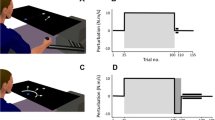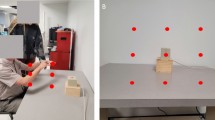Abstract
The autistic child's presumed preference for proximal rather than distal sensory input was studied by requiring that autistic, retarded, and normal subjects adapt to a prism-induced lateral displacement of the visual field. Only autistic subjects demonstrated transfer of adaptation to the nonadapted hand, indicative of a reliance on proprioception rather than vision to accomplish adaptation. Such reliance on proprioception was explained as an alternative strategy compensating for an inability to use current visual control of reaching rather than as a preference for proximal information per se.
Similar content being viewed by others
References
Anthony, J. An aetiological approach to the diagnosis of psychosis in childhood.Review of Psychiatry of the Infant, 1958,25, 89–95.
Bergman, P., & Escalona, S. K. Unusual sensitivities in very young children.Psychoanalytic Study of the Child, 1949,314, 333–353.
Bower, T. G. R.Development in infancy. San Francisco: W. H. Freeman, 1974.
Bruner, J. S. Organization of early skilled action.Child Development, 1973,44, 1–11.
Cohen, M. Continuous versus terminal visual feedback in prism aftereffects.Perceptual and Motor Skills, 1967,24, 1295–1298.
Eveloff, H. H. The autistic child.AMA Archives of General Psychiatry, 1960,3, 66–81.
Frith, U., & Hermelin, B. The role of visual-motor cues for normal, subnormal and autistic children.Journal of Child Psychology and Psychiatry, 1969,10, 153–163.
Gibson, J. J. Adaptation, aftereffects and control in the perception of curved lines.Journal of Experimental Psychology, 1933,16, 1–31.
Goldfarb, W. Receptor preference in schizophrenic children.AMA Archives of Neurological Psychiatry, 1956,76, 643–652.
Goldfarb, W.Schizophrenic children. Cambridge: Harvard University Press, 1961.
Harris, C. S. Adaptation to displaced vision: visual, motor or proprioceptive?Science, 1963,140, 812–814.
Hays, W. L.Statistics for psychologists. New York: Holt, Rinehart & Winston, 1966.
Hermelin, B. Locating events in space and time: experiments with autistic, blind and deaf children.Journal of Austism and Childhood Schizophrenia, 1972,2, 288–298.
Hermelin, B., & O'Connor, N.Psychological experiments with autistic children. Elmsford, New York: Pergamon Press, 1970.
Hofsten, C. U., & Lindhagan, K. Observations on the development of reaching for moving objects.Journal of Experimental Psychology, 1979,28, 158–173.
Howard, I. P.Human visual orientation. New York: Wiley, 1981.
Kornheiser, A. S. Adaptation to laterally displaced vision; a review.Psychological Bulletin, 1976,83, 783–816.
Lovaas, I., Schreibman, L., Koegel, R., & Rehm, R. Selective responding by autistic children to multiple sensory input.Journal of Abnormal Psychology, 1971,77, 211–222.
Masterton, B. A.The use of visual feedback by autistic children. Doctoral dissertation, University of Toronto, 1981.
McDonnell, P. M. The development of visually guided reaching.Perceptual Psychophysics, 1975,18, 181–185.
National Society for Autistic Children. National Society for Autistic Children definition of the syndrome of autism.Journal of Autism and Childhood Schizophrenia, 1978,8, 162–167.
Ornitz, E. M. Childhood autism; a disorder of sensory motor integration. In M. Rutter (Ed.)Infantile autism: Concepts, characteristics and treatment. London: Churchill Livingston, 1971.
Ornitz, E. M. The modulation of sensory input and motor output in autistic children.Journal of Autism and Childhood Schizophrenia, 1974,4, 197–215.
Ornitz, E. M., & Ritvo, E. R. Neurological mechanisms underlying perceptual inconstancy in autistic and schizophrenic children.AMA Archives of General Psychiatry, 1968,19, 22–31. (a)
Ornitz, E. M., & Ritvo, E. R. Perceptual inconstancy in early infantile autism.AMA Archives of General Psychiatry, 1968,18, 79–98. (b)
Rimland, B.Infantile autism. New York: Appleton-Century-Crofts, 1964.
Rock, I., & Harris, C. S. Vision and touch.Scientific American, 1967,248, 96–107.
Schopler, E. Early infantile autism and receptor processes.AMA Archives of General Psychiatry, 1965,13, 327–335.
Schopler, E. Visual vs. tactile receptor preference in normal and schizophrenic children.Journal of Abnormal Psychology, 1966,71, 108–114.
Van Krevelen, D. A. Early infantile autism.Acta Paedopsychiatrica, 1952,30, 303–323.
Wing, J. V. Diagnosis, epidemiology, aetiology. In J. V. Wing (Ed.),Early childhood autism: Clinical, educational and social aspects. London: Pergamon Press, 1966.
Author information
Authors and Affiliations
Rights and permissions
About this article
Cite this article
Masterton, B.A., Biederman, G.B. Proprioceptive versus visual control in autistic children. J Autism Dev Disord 13, 141–152 (1983). https://doi.org/10.1007/BF01531815
Issue Date:
DOI: https://doi.org/10.1007/BF01531815




